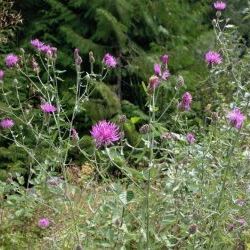
Priority: Strategic Control
General: Branching plant with pink-purplish flowers in the Sunflower family.
Height: Grows between 0.2-1.8m tall.
Flowers: Flowering heads are single on the top of branching stems. The bracts under the petal area have a dark edge giving that area a spotted look. Flowers can sometimes be white.
Leaves/Stems: Erect stems that are often branching. Leaves in first year plants (rosette) are up to 15cm long and deeply lobed with smooth edges. Leaves grow out of the stem in an alternate pattern. Leaves become smaller near the top of the plant.
Root: Taproot.
None
Diffuse knapweed and other knapweed species.
Differences: The main difference is that Spotted Knapweed has the dark edges of the floral bracts. Hybridization between Diffuse & Spotted knapweed can cause confusion. If it is hard to identify, please contact LRISS for assistance. There are other knapweeds with pink to purple flowers that should be reported.
Where did it come from? Europe.
Where does it grow here? Spotted knapweed is found in most places in our region. It prefers disturbed areas and can be found on roadsides, gravel pits and forestry landings. It will grow in areas that receive more moisture whereas Diffuse likes drier areas. This is why Spotted Knapweed is thriving in the Bridge River Valley area as well as the Marble Canyon as well.
Reproduction: By seed. One plant can produce 140,000 seeds in 1m2. Seeds can remain dormant and viable in the soil for up to 8 years.
When does it grow, flower & seed? Sprouts April-June. Flowers July-October. Seeds November.
Spreads By: Activities that disturb soil can spread Spotted Knapweed including road grading, road building, forest harvesting, and gravel extraction.
Plant Type: Perennial.
- Decrease native plants when it takes over areas with dense infestations. It has caused deterioration to BC’s interior grasslands, forests & rangelands.
- Decrease forage for livestock & wildlife.
- Causes skin irritation for people. Wear gloves and long sleaves to handle this plant.
- Unpalatable to livestock. If ingested, by accident, it can injure the mouth or digestive tract of livestock.
- Increased fire risk due to buildup of dead plants.
- Seed can contaminate gravel and soil sources.
- Review your property regularly for this species. Prevent the establishment of this plant.
- Treatment Remove small patches before it flowers & sets seed. Digging and hand-pulling can be effective for small infestations. There are 12 bioagents that have been released in BC and our region to reduce the vigor of this plant.
- Cover bare patches or disturbed soil by planting or seeding with non-invasives.
- Check areas where you have removed invasives for any new plants that year and in future growing seasons.
- Dispose of invasive plants responsibly. Bag them for disposal at the local landfill. Composting and burning are not recommended.
- Contact LRISS for specific treatment recommendations.
Southern Interior Weed Management Committee. 2016. Invasive Plants of the Southern Interior BC. 86pgs.
Okanagan Invasive Species Online website.
